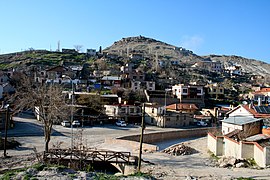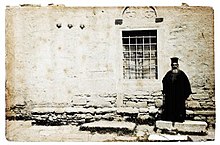| Sille | |
|---|---|
| Neighbourhood | |
 A general view of the town of Sille A general view of the town of Sille | |
  | |
| Coordinates: 37°55′35″N 32°25′0″E / 37.92639°N 32.41667°E / 37.92639; 32.41667 | |
| Country | Turkey |
| Province | Konya |
| District | Selçuklu |
| Population | 1,191 |
| Time zone | UTC+3 (TRT) |
| Area code | 0332 |




Sille, also known as Sille Subaşı and historically Sylata, is a neighbourhood of the municipality and district of Selçuklu, Konya Province, Turkey. Its population is 1,191 (2022).
Sille Subaşı was one of the few villages where the Cappadocian Greek language was spoken until 1922. It was inhabited by Greeks who had been living there in peaceful coexistence with the nearby Turks of Konya for over 800 years.
The reason for this peaceful coexistence was Jalal al-Din Muhammad Rumi, who was the witness of a miracle that happened at the nearby Orthodox Christian monastery of Saint Chariton. In the Turkish language the monastery is now called Akmanastir and is translated as, "White Monastery". Jalal al-Din Rumi constructed a small mosque inside the Saint Chariton monastery. It is also notable that Jalal al-Din Rumi wrote Greek poems using the Arabic-Turkish script, while Greek Sille villagers wrote Turkish using the Greek alphabet scripting. This form of writing spread across the region and was commonly known as Karamanli Turkish writing.
Mevlana asked the Turks never to hurt the Greeks of the village, and assigned to the Greek villagers the task of cleaning his own tomb. The Turks respected his commandment. In turbulent times, several firmans from the Sultan were sent to Konya Turks, which reminded them of their promise not to hurt the Sille villagers. The coexistence of Sille Greeks with the nearby Turks remained peaceful, which is why the villagers managed to preserve for over eight centuries both their native Greek language and their Orthodox Christian religion.
In the population exchanges between Greece and Turkey (1923), Turkey and Greece expelled their respective Christian and Muslim populations to the other. After 1924, all Greeks had left the village. The majority of this population relocated to the Nea Silata village in Chalkidiki, Greece.
Currently, the village is protected and renovation efforts were conducted for preservation and touristic purposes.
References and notes
- Mahalle, Turkey Civil Administration Departments Inventory. Retrieved 19 September 2023.
- "Address-based population registration system (ADNKS) results dated 31 December 2022, Favorite Reports" (XLS). TÜİK. Retrieved 19 September 2023.
- "While Mevlana's own son was falling from this cliff, he was saved by the saint Khariton." M. SABRİ DOĞAN
- E.J. Brill's First Encyclopaedia of Islam 1913-1936. BRILL. 1987. ISBN 9004082654.
- Nick Nicholas. "Greek Verses of Rumi & Sultan Walad". Archived from the original on 4 June 2023.
- Modern Greek in Asia Minor: A study of dialect of Silly, Cappadocia and Pharasa (Cambridge: Cambridge University Press, 1916), by Richard MacGillivray Dawkins (1871–1955)
External links
| Neighbourhoods of Selçuklu District | |
|---|---|
|
This geographical article about a location in Konya Province, Turkey is a stub. You can help Misplaced Pages by expanding it. |